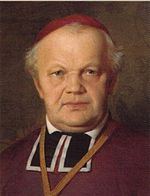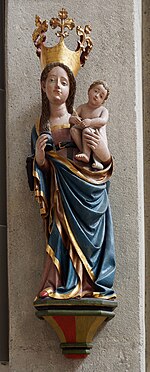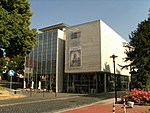Bernward Column

The Bernward Column (German: Bernwardssäule) also known as the Christ Column (German: Christussäule) is a bronze column, made c. 1020 for St. Michael's Church in Hildesheim, Germany, and regarded as a masterpiece of Ottonian art. It was commissioned by Bernward, the thirteenth bishop of Hildesheim in 1020, and made at the same time. It depicts images from the life of Jesus, arranged in a helix similar to Trajan's Column: it was originally topped with a cross or crucifix. During the 19th century, it was moved to a courtyard and later to Hildesheim Cathedral. During the restoration of the cathedral from 2010 to 2014, it was moved back to its original location in St. Michael's, but was returned to the Cathedral in August 2014.
Excerpt from the Wikipedia article Bernward Column (License: CC BY-SA 3.0, Authors, Images).Bernward Column
Domhof, Hildesheim Altstadt (Stadtmitte/Neustadt)
Geographical coordinates (GPS) Address Website Nearby Places Show on map
Geographical coordinates (GPS)
| Latitude | Longitude |
|---|---|
| N 52.1489 ° | E 9.9472 ° |
Address
Hoher Dom St. Mariä Himmelfahrt
Domhof 17
31134 Hildesheim, Altstadt (Stadtmitte/Neustadt)
Lower Saxony, Germany
Open on Google Maps










